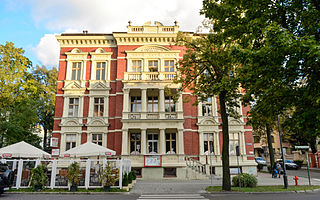
Zielona Góra is the largest city in Lubusz Voivodeship, located in western Poland, with 140,403 inhabitants (2021). The region is closely associated with vineyards and holds an annual Wine Fest. Zielona Góra is one of the two capital cities of Lubusz Voivodeship, hosting the province's elected assembly, while the seat of the centrally appointed governor is in the city of Gorzów Wielkopolski.

Lubusz Voivodeship is a voivodeship (province) in western Poland.

Rotenburg an der Wümme is a town in Lower Saxony, Germany. It is the capital of the district of Rotenburg.

Brzeg is a town in southwestern Poland with 34,778 inhabitants and the capital of Brzeg County. It is situated in Silesia in the Opole Voivodeship on the left bank of the Oder river.
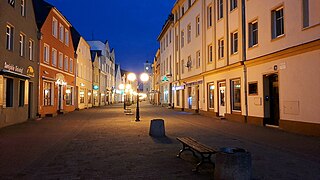
Żagań is a town in western Poland, on the Bóbr river, with 25,731 inhabitants (2019). The town is the capital of Żagań County in the historic region of Silesia. Previously in the Zielona Góra Voivodeship (1975–1998), Żagań has been in the Lubusz Voivodeship since 1999.

Krosno Odrzańskie is a town in Lubusz Voivodeship in western Poland, on the east bank of Oder River, at the confluence with the Bóbr. With 11,319 inhabitants (2019) it is the capital of Krosno County.

Babimost is a town in Zielona Góra County, Lubusz Voivodeship, western Poland. It is the administrative seat of Gmina Babimost. Babimost has an area of 3.65 square kilometres, and as of June 2022 it has a population of 3,848.

Wschowa is a town in the Lubusz Voivodeship in western Poland with 13,875 inhabitants (2019). It is the capital of Wschowa County and a significant tourist site containing many important historical monuments. It is part of the historic region of Greater Poland. Once an important royal city of Poland, due to its 18th-century history, it is sometimes called the "unofficial capital of Poland".
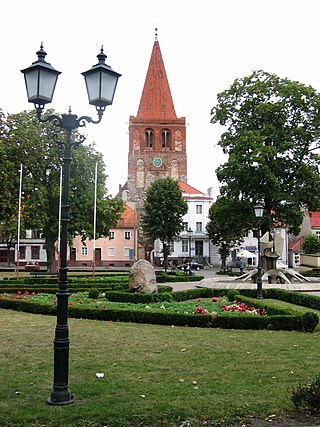
Myślibórz is a town in northwestern Poland, in West Pomeranian Voivodeship. It is the capital of the Powiat of Myślibórz, with a population of 11,867.

Lower Silesia is a historical and geographical region mostly located in Poland with small portions in the Czech Republic and Germany. It is the western part of the region of Silesia. Its largest city is Wrocław.

Bytom Odrzański is a town on the Oder river in western Poland, in Nowa Sól County of Lubusz Voivodeship. As of December 2021, the town has a population of 4,191.

Niemcza is a town in Dzierżoniów County, Lower Silesian Voivodeship, in south-western Poland. It is the seat of the administrative district (gmina) called Gmina Niemcza.
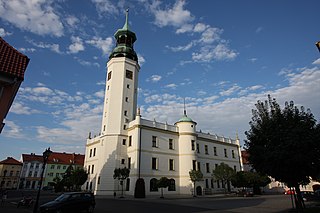
Sulechów is a town located within the Zielona Góra County, in Lubusz Voivodeship, western Poland. It is the administrative seat of the Gmina Sulechów. Established in the Middle Ages, the town features many historical monuments significant to the Polish Lubusz region. The town limits cover 6.88 square kilometres (2.66 sq mi).

Otyń is a town in western Poland, located in the Nowa Sól County, Lubusz Voivodeship. As of 2019 it has 1,615 inhabitants. It lies approximately 6 kilometres (4 mi) north of Nowa Sól and 18 km (11 mi) south-east of Zielona Góra.

Cybinka is a town in western Poland, in Słubice County, Lubusz Voivodeship. It is the administrative seat of the Gmina Cybinka.

Ostroróg is a town in Szamotuły County, Greater Poland Voivodeship, Poland, with 1,962 inhabitants (2010).

Gmina Przewóz is a rural gmina in Żary County, Lubusz Voivodeship, in western Poland, on the German border. Its seat is the village of Przewóz, which lies approximately 22 kilometres (14 mi) south-west of Żary and 64 km (40 mi) south-west of Zielona Góra.
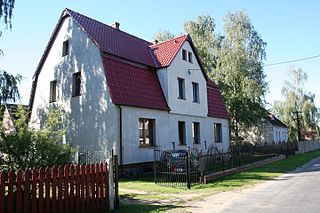
Rąpice is a village in the administrative district of Gmina Cybinka, within Słubice County, Lubusz Voivodeship, in western Poland, close to the German border. It lies approximately 11 kilometres (7 mi) south-west of Cybinka, 29 km (18 mi) south-east of Słubice, 57 km (35 mi) west of Zielona Góra, and 77 km (48 mi) south-west of Gorzów Wielkopolski. It is located within the historic Lubusz Land.

Sądów is a village in the administrative district of Gmina Cybinka, within Słubice County, Lubusz Voivodeship, in western Poland, close to the German border. It lies approximately 3 kilometres (2 mi) north-east of Cybinka, 24 km (15 mi) south-east of Słubice, 56 km (35 mi) north-west of Zielona Góra, and 64 km (40 mi) south-west of Gorzów Wielkopolski. It is located within the historic Lubusz Land.

Nietków is a village in the administrative district of Gmina Czerwieńsk, within Zielona Góra County, Lubusz Voivodeship, in western Poland. It lies approximately 21 kilometres (13 mi) north of Czerwieńsk, 30 km (19 mi) north of Zielona Góra, and 61 km (38 mi) south of Gorzów Wielkopolski.
























